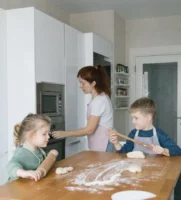
17 Jun Fun And Simple Tactile Exercises To Try With Your Child
 Navigating the world of sensory play can be both fun and educational for parents and children. Engaging children in simple tactile exercises not only supports their sensory experiences but also aids in their overall development. From the squishy delight of homemade slime to the soothing textures of sand art, these activities offer meaningful ways to develop the tactile system.
Navigating the world of sensory play can be both fun and educational for parents and children. Engaging children in simple tactile exercises not only supports their sensory experiences but also aids in their overall development. From the squishy delight of homemade slime to the soothing textures of sand art, these activities offer meaningful ways to develop the tactile system.
Incorporating activities like these into your daily routine can be especially beneficial for children requiring additional sensory input. Occupational therapy fine motor activities, such as kneading playdough or molding clay, can significantly improve their fine motor skills while providing a therapeutic, sensory-rich experience. It’s important to note that such activities are not only entertaining but also essential for strengthening fine motor control and sensory integration.
By exploring various tactile exercises, parents can provide their children with valuable sensory experiences that foster growth and learning. Activities like filling a sandbox or creating DIY slime can be both enjoyable and foundational for their cognitive and physical development. These tactile activities can serve as excellent tools in a child’s growth journey, combining playfulness with educational value. Please keep in mind that this is only an informative article and not medical advice; if you need further help, contact a medical expert.
Key Takeaways
- Tactile exercises enhance sensory experience and overall development.
- Occupational therapy fine motor activities improve fine motor skills and sensory integration.
- Simple activities like sand art and DIY slime offer fun, beneficial playtime.
Exploring Tactile Sensory Activities
Tactile sensory activities provide children with a rich and engaging sensory experience, helping to improve their sensory integration and fine motor skills. These activities leverage various textures, temperatures, and materials to stimulate the sense of touch and enhance sensory perception.
Understanding the Basics
Tactile sensory activities focus on engaging the sensory receptors in the skin. These activities often involve different textures like sand, rice, or shaving cream, which provide varied sensations. The aim is to expose children to a range of tactile inputs, helping them to better process and respond to these sensations. Sensory bins filled with diverse materials can be excellent tools for such activities, offering a controlled way to explore.
Therapist-approved toys and tools like stress balls or playdough also play a crucial role. These items are designed to deliver specific sensory stimuli that can aid in developing a child’s sensory processing skills. Understanding these basics helps in selecting appropriate activities that can benefit children’s sensory systems effectively.
Activities to Enhance Touch Perception
One effective activity is creating a sensory bin. Fill it with materials such as dried beans, rice, or sand. This allows children to dig, scoop, and explore textures. Adding tactile elements like feathers, sponges, and fabric scraps can further enrich the experience.
Crafts such as making and molding playdough or clay provide a hands-on way to explore textures. These activities encourage hands-on exploration and offer a wide range of tactile sensations that can be both calming and stimulating.
Developing Fine Motor Skills
Fine motor skills can be developed through tactile sensory play like kneading playdough or squeezing stress balls. These activities strengthen the small muscles in the hands and fingers, which are essential for tasks like writing and buttoning clothes.
Engaging in activities that require pinching, rolling, and flattening materials like clay or playdough builds dexterity and coordination. Sensory activities involving Legos or Duplo blocks are great for fine motor skill development. They provide resistance and require precise movements, enhancing hand-eye coordination.
Using tools such as tweezers to pick up small objects from sensory bins can also enhance precision and control. These activities provide essential sensory input while building the fine motor skills necessary for everyday tasks.
Creative Tactile Play and Learning
Engaging children in tactile play can improve their sensory development and provide a therapeutic experience. Using natural textures, crafting materials, and specialized sensory activities can make playtime both fun and educational.
Fun with Natural Textures
 Natural textures offer a rich sensory experience for children. Activities like playing in sandboxes or creating sand art can enhance tactile sensory activities for children. Gardening is another excellent option, allowing kids to touch soil, plants, and mud. Nature walks can introduce various textures like leaves, pinecones, and stones. Mud play involves tactile sensory activities for children that are beneficial for those with sensory processing disorders (SPD).
Natural textures offer a rich sensory experience for children. Activities like playing in sandboxes or creating sand art can enhance tactile sensory activities for children. Gardening is another excellent option, allowing kids to touch soil, plants, and mud. Nature walks can introduce various textures like leaves, pinecones, and stones. Mud play involves tactile sensory activities for children that are beneficial for those with sensory processing disorders (SPD).
Crafting with Tactile Materials
Crafting with tactile materials can offer a hands-on learning experience. Finger painting allows children to explore color and texture with their hands, which is particularly useful for early learning. Glitter and beads can be integrated into various art projects, providing different tactile sensations.
Playdough is a versatile material that can be rolled, stretched, and flattened, offering ample opportunity for sensory play. Textured toys such as those featuring ridges or bumps can also be used to introduce different tactile sensations in a controlled manner.
Sensory Play for Special Needs
Sensory play is crucial for children with special needs, including those on the autism spectrum. Deep pressure activities, such as squeezing stress balls or rolling in a weighted blanket, provide calming sensations that can help in managing anxiety. Tactile sensory activities for autism often include manipulating soft, firm, and varied textures to improve sensory integration.
Sensory bins filled with materials like water beads, rice, or textured fabrics can be immensely beneficial. SPD activities such as these can support sensory development and offer a therapeutic escape. Specialized tactile activities for kindergarten can also be adapted to meet the sensory needs of all children, making inclusive play a reality.
Conclusion
Engaging children in tactile activities offers numerous benefits, from improvement in sensory processing to enhanced fine motor skills. Such exercises can be easily integrated into daily routines, making playtime both fun and educational. Whether using simple household items or specially designed toys, these activities help foster a child’s curiosity and development.
The information on MedicalResearch.com is provided for educational purposes only, and is in no way intended to diagnose, cure, or treat any medical or other condition.
Some links may be sponsored. Products are not endorsed.
Always seek the advice of your physician or other qualified health and ask your doctor any questions you may have regarding a medical condition. In addition to all other limitations and disclaimers in this agreement, service provider and its third party providers disclaim any liability or loss in connection with the content provided on this website
Last Updated on June 17, 2024 by Marie Benz MD FAAD
